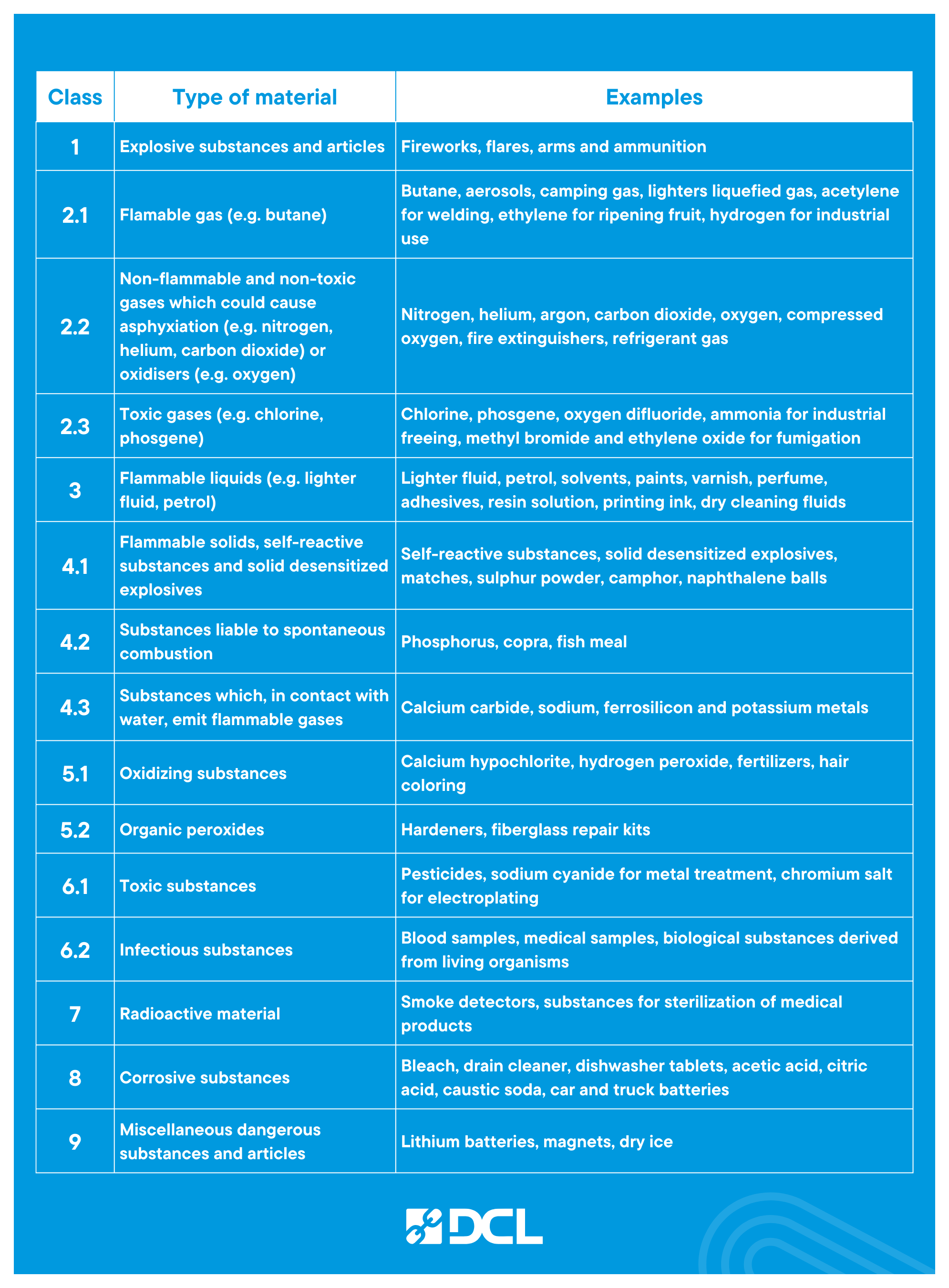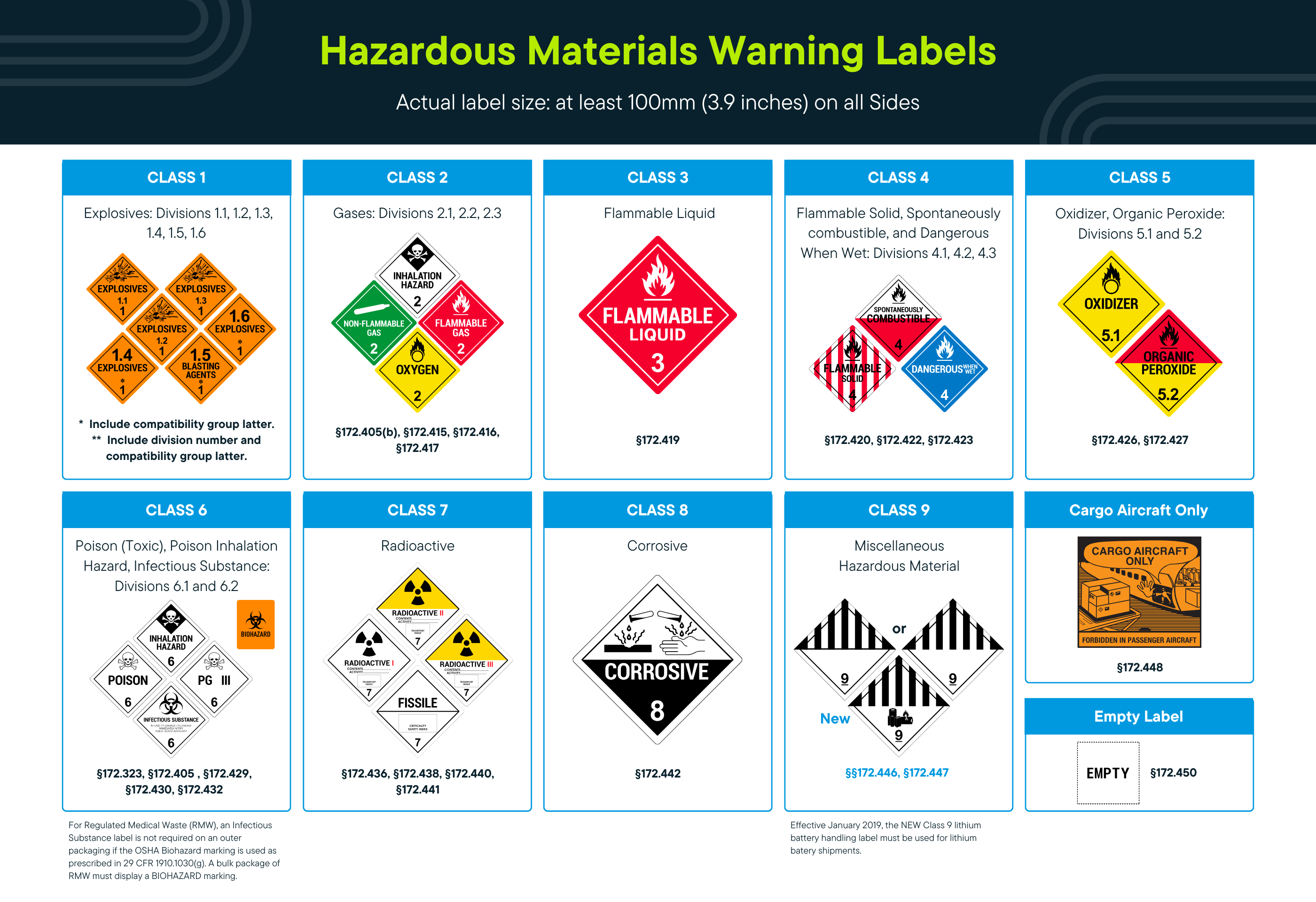
Shipping dangerous goods (also known as hazardous material or hazmat) is a complicated undertaking when shipping domestically. If your ecommerce business ships on a global scale, shipping dangerous goods across borders can be even more complex due to strict international regulations.
Each country has its own policies on hazardous materials based on the hazard class they are assigned. These goods can vary widely, but include lithium ion batteries, and battery powered devices, aerosols, oxygen cylinders, and flammable materials.
Both the US Department of Transportation (US DOT) require that all staff who handle hazmat items are trained and certified before handling, labeling, and shipping hazardous materials.
There are fines for non-compliance and potential legal action if you are found to have ignored hazardous materials shipping regulations.
Because of these complications you might want to consider partnering with a third-party logistics provider (3PL) who will take care of all the necessary requirements to make sure your dangerous goods are shipped properly. This post will help you better understand what dangerous goods are and explain some best practices for shipping them. If you still have questions a 3PL partner would be a good resource for advice for your businesses individual needs.
Identify the Dangerous Goods
First, you need to correctly identify which type of dangerous goods you are planning to send, as there are different restrictions on goods depending on its classification. Keep in mind there are many items which could be difficult to classify as “dangerous” as they may not be dangerous by themselves, but do contain a dangerous component.
There are nine classes of dangerous goods, as well as a few sub-classes. The below information breaks them down by category.
Certain types of dangerous goods could be banned from certain countries, so you should confirm that you can import what you are sending before you proceed. Although a country may accept these dangerous goods, there’s still a possibility that there are no carriers would be willing to ship the goods there. Shippers usually provide a list of dangerous items including aerosols, weapons, and flammable materials which are often regulated by import countries and air freight providers, so make sure you know if your shipment contains any of these before you send it.

Don’t Ship Dangerous Goods by Air
The IATA(The International Air Transport Association), the international organization regulating air travel, has standards that restrict certain hazardous substances from being shipped by air.
Due to IATA’s dangerous goods regulations, many products can’t be shipped via air freight. These goods would then need to be shipped via ground freight or ocean freight, if going overseas. While this will be a much cheaper option for you, it will take a lot longer for the customer to receive their products.
For ecommerce brands with electronic devices, cameras, cosmetics and perfumes, dangerous goods shipments can pose a problem if they need to ship products quickly. If you have any components that are considered dangerous goods, always research beforehand what the shipping limits are, as they change often, can put people at risk, and can also land your company fines from foreign governments who are cracking down on undeclared dangerous goods shipments. Being unaware of the rules and regulations is not an acceptable reason for errors when shipping dangerous goods. You have to make sure you are in compliance with the law when shipping these goods.
Double Check Your Documentation
Getting your shipping papers right when sending a dangerous goods shipment is important, and also the key to ensuring your shipment goes smoothly. When making a dangerous goods shipment, ensure that all dangerous items are declared in your air waybill and commercial invoice under “Item Description”. Any errors in this documentation can lead to massive delays at customs.
Most dangerous goods shipments need a hazard label identifying the risk coming from the package, and a UN-number identifying the type of dangerous goods in the shipment. Potential hazards are usually identified in the Safety Data Sheet (SDS), also called a Material Safety Data Sheet, or MSDS. If you are shipping aerosols, batteries, or a fragile container your shipment will also require additional stickers and labels to show this on the box. All hazard labels should be clear and easy for anyone to see.
Source: Federal Aviation Administration

Pack Your Goods Carefully
One of the main reasons hazmat items are classified as “dangerous” is the risk they pose during transport. Pack your orders carefully to ensure that no damage comes to the products while and that those handling the package are safe from harm.
Whether it’s a combustible, flammable liquid, infectious substance, corrosive, or other type of hazmat, make sure that your shipment is packaged according to regulation. If your packaging is not adequate enough, it may cause delays to your shipment.
There are different rules according to the code of federal regulations, depending on the amount you are carrying, for the safe transport of dangerous goods.
Consider Splitting Your Shipments
If claiming your shipment as dangerous goods is something you want to avoid altogether, you could ask your shipper if it is possible to split your shipment. If this is an option, it can save you a lot of time as you will not have to deal with dangerous goods documentation, and goods will not have to undergo special procedures in order to be shipped.
In some cases, sending multiple shipments as a normal goods shipment may be cheaper than one dangerous goods shipment. This is common in the case of mobile phones and notebook computers, where it is possible to make your shipment smaller than the threshold. However, this option is not risk-free.
It could end up being more troublesome and inefficient for you because shippers can impose limitations not only on the number of dangerous goods per shipment, but also on the number of dangerous goods shipments per day. That could mean you would end up having to arrange multiple shipments over several days.
Be Prepared to Pay Additional Handling Fees
All shippers add an additional surcharge for dangerous goods/hazmat materials, due to the extra risks involved with handling and processing DG items. There are usually two categories that the shippers will put dangerous goods into when assessing surcharges.
- Accessible Dangerous Goods (ADG): The content of package must be accessible during transit for security reasons.
- Inaccessible Dangerous Goods (IDG): The content of package does not have to be accessed during transit and can be mixed with other freight.
Accessible dangerous goods often have a higher surcharge.
- For example, with FedEx Express U.S. package shipments containing accessible dangerous goods, the surcharge is $160 per package. For shipments containing inaccessible dangerous goods, the surcharge is $73 per package.
- For UPS accessible dangerous goods domestic shipments incur a $93-$146 surcharge depending on the service, while inaccessible dangerous goods have a surcharge of $46-$72, depending on the service.
Add on top of these surcharges, for some types of DG products dry ice is required, which may incur an additional $5-$10 per package flat fee.
Insurance for dangerous goods is also more expensive due to the added risk of handling them. Some shippers require you to take insurance on your shipment to cover both the shipper’s health and safety risk, and can even refuse to cover your shipment for any damage which may occur in transit.
Bottom Line
There are many things to be aware of when shipping dangerous goods. To meet all regulatory standards you’ll need to have secure packaging, complete documentation, and correct labelling you will experience less obstacles and delays when transporting shipments containing hazardous substances.
Partnering with a 3PL is another way to avoid the hassle with figuring out all of the rules and regulations required to handle dangerous goods.
If you are looking for a 3PL partner with experience in dangerous goods regulation and compliance, we would love to hear from you. You can read DCL’s list of services to learn more about what we do, or check out the many companies we work with. Send us a note to connect about how we can help your company grow.
Tags: International





